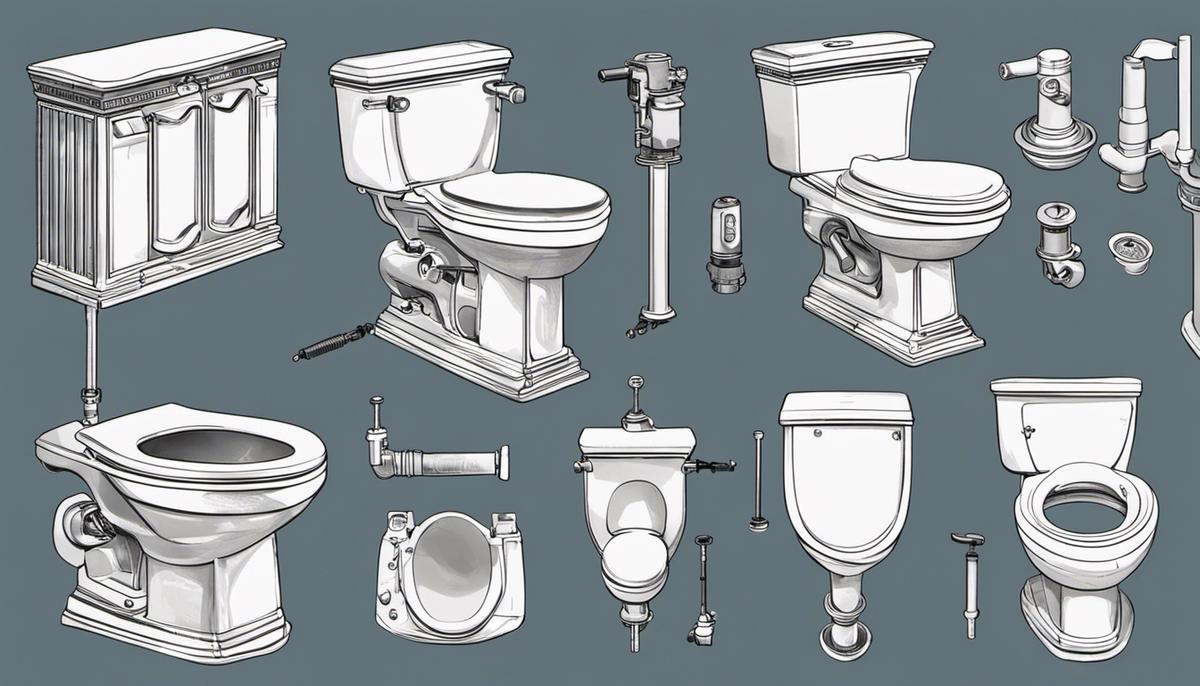Urinary Tract Infections (UTIs) are a common, pervasive health issue, impacting millions each year. From their typical symptoms to potential risk factors, understanding these infections can provide critical insights into prevention and treatment strategies.
As common as they are, there are still many misconceptions surrounding their causes. Among the more concerning potential culprits is something as mundane and everyday as toilet paper.
But Can Toilet Paper Cause Urinary Tract Infection?
Through a careful analysis of the material and chemicals inherent in various toilet papers’ composition and how these could potentially influence the user’s health, this exploration aims to shed light on the subject and confront this question head on.
Deciphering Urinary Tract Infections (UTIs)
Understanding Urinary Tract Infection
A Urinary Tract Infection (UTI) is an infection that affects any part of the urinary system, which includes the kidneys, bladder, ureters, and urethra. While UTIs can affect any gender, women are often at greater risk.
According to Centers for Disease Control and Prevention (CDC), almost half of all women will have at least one UTI during their lifetime.
Symptoms of UTIs can include a burning sensation during urination, frequent urges to urinate, lower abdominal pain or pressure, cloudy and strong-smelling urine, and feeling tired or shaky. In some cases, a fever can indicate that the infection has reached the kidneys.
Causes and Risk Factors of UTI
| Causes of UTIs | Risk Factors for UTIs |
|---|---|
| Bacterial Infection | Female Gender |
| E. coli (most common) | Sexual Activity |
| Improper Hygiene | Pregnancy |
| Catheter Use | Menopause |
| Urinary Tract Obstruction | Urinary Tract Abnormalities |
| Diabetes | Weakened Immune System |
| Sexual Intercourse | Aging |
| Dehydration | Kidney Stones |
| Bowel Incontinence | Reduced Fluid Intake |
UTIs are commonly caused by bacteria entering the urinary tract through the urethra and multiplying in the bladder.
The shorter urethra in women makes them more susceptible to UTIs as the bacteria have a shorter distance to travel.
Other risk factors include a suppressed immune system, sexual activity, certain types of birth control, and issues emptying the bladder completely.
Misconceptions Around the Causes of UTIs
One common misconception is that toilet paper can cause UTIs. This misconception probably arises from the correct advice that, for women, wiping from front to back after going to the toilet can prevent bacteria in the anal region spreading to the vagina and urethra.
However, it should be clarified that toilet paper itself does not cause UTIs. UTIs are caused by the transfer of bacteria into the urinary tract, often from the bowel or feces.
The material or color of the toilet paper also does not have any impact on the likelihood of contracting a UTI.
However, some people may experience skin sensitivity or allergic reactions to colored or scented toilet papers, leading to discomfort or irritation in the urethral area.
How Toilet Paper and Hygiene Habits Affect UTI Risk
Although toilet paper in itself cannot directly cause a Urinary Tract Infection (UTI), maintaining proper toilet hygiene significantly helps in its prevention.
Employing the right wiping method, specifically from front to back, can minimize the likelihood of bacterial movement from the anal area to the urethra.
It’s also recommended to urinate before and after any sexual engagement, as this could aid in expelling any bacteria that may have penetrated the urethra.
In summary, while toilet paper isn’t a direct cause for UTIs, adhering to good toilet hygiene could inhibit bacterial transfer into the urinary tract, thereby noticeably reducing the chance of a UTI development.

Toilet Paper: Material and Chemicals Composition
The Composition and Potential Health Implications of Toilet Paper
Daily, everyone depends on toilet paper, a home necessity primarily produced from pulp obtained either from fresh trees or recycled paper.
This production involves several chemical treatments which include bleaching, crucial for providing toilet paper its characteristic white shade.
For the bleach process, manufacturers often resort to using chlorine compounds or dioxins which, although efficient for their intended function, could pose certain health implications.
Chemical Element in Toilet Paper Production
The use of chlorine in the manufacturing process leads to the production of dioxins, which are known carcinogens.
Exposure to dioxins can lead to a range of health problems, such as respiratory issues or even reproductive difficulties.
Although the concentrations of these chemicals left in the finished product are relatively low, the daily use of toilet paper over the years can allow some level of these chemicals to accumulate in the body.
Furthermore, many brands of toilet paper include additional chemicals meant to provide a softer texture and pleasant fragrance.
These can include formaldehyde and phthalates, among others. Like dioxins, these are chemicals known to be harmful in certain contexts or concentrations, and their long-term impact on human health is not fully understood.
Impacts on Urinary Tract Health
Directly associating toilet paper to urinary tract infections (UTIs) is challenging because UTIs typically arise from bacteria, most commonly E.coli, entering the urethra and bladder.
However, the chemicals present in toilet paper could potentially irritate the sensitive tissues around the perineum and urethral area, which could create conditions where bacteria could more likely cause an infection.
Toilet Paper Usage and UTI Risk
| Toilet Paper Usage | UTI Risk |
|---|---|
| Excessive wiping | High |
| Rough or abrasive paper | High |
| Incorrect wiping direction (back to front) | High |
| Insufficient wiping | Moderate |
| Use of soft, gentle paper | Low |
| Proper wiping technique (front to back) | Low |
| Adequate hygiene practices | Low |
Another pivotal aspect is how toilet paper is used. For instance, wiping from back to front can spread bacteria from the anal area to the vagina or urethra leading to an infection. The optimal practice to prevent this is to always wipe front to back.
Non-Chemical Risks of Toilet Paper and UTIs
Non-chemical factors can also play a role in the development of UTIs.
For example, small fragments of toilet paper can sometimes be left behind after wiping, and these paper remnants can potentially serve as a breeding ground for bacteria, significantly if personal hygiene and frequent underwear changes are not maintained.
As a carrier for bacteria, these can potentially lead to infections given the right conditions.
Alternatives to Conventional Toilet Paper
| Alternative | Description | Benefits |
|---|---|---|
| Flushable Wipes | Pre-moistened wipes designed for sensitive skin. | Extra cleanliness, gentle on skin. |
| Bidet Attachment | Device that sprays water for cleansing. | Thorough and hygienic cleaning. |
| Reusable Cloth | Soft, washable fabric squares or wipes. | Eco-friendly, gentle, and durable. |
| Feminine Wash | pH-balanced cleansers for intimate hygiene. | Prevents irritation, maintains pH. |
| Tissue Spray | Water-based spray for moistening tissue. | Reduces friction and discomfort. |
| Portable Bidet | Handheld device for on-the-go cleansing. | Convenient for travel and outings. |
Those concerned about the potential impacts of toilet paper on their urinary tract health might consider alternatives to conventional toilet paper.
These can include unbleached, chlorine-free brands, hypoallergenic toilet paper, or bidets which reduce or eliminate the physical irritation and chemical exposure risks associated with toilet paper.
Examining the Implications of Toilet Paper Use for Health
The potential role of toilet paper in urinary tract infections (UTIs) should always be evaluated within the greater web of potential risk variables.
These variables can include, but are not limited to, sexual activity, the state of menopause, bladder and kidney complications, and the use of certain birth control methods.
While the kind and usage of toilet paper can have a bearing on your urinary tract’s health, it is but one element in a complex interplay of factors influencing this condition.

Can Toilet Paper Cause UTIs?
No, toilet paper itself does not cause urinary tract infections (UTIs). UTIs are typically caused by bacteria entering the urinary tract. However, using harsh or scented toilet paper can potentially irritate the genital area, making it more susceptible to UTIs in some individuals. To prevent UTIs, it’s important to maintain good hygiene and avoid using irritating products.
The Interplay Between Toilet Paper Use and Urinary Tract Infections
Urinary Tract Infections (UTIs) are generally caused by bacteria that find their way into the urinary tract via the urethra, and then multiply once they’ve reached the bladder. This could be spurred on by a variety of factors: sexual activity, types of contraceptive measures, and the period of menopause in women, to name a few.
Interestingly though, the use of toilet paper per se doesn’t directly lead to UTIs.
However, the manner in which the toilet paper is used could inadvertently heighten the risk.
For this reason, recommended toilet hygiene guides suggest wiping from front to back to circumvent any unintentional transfer of bacteria from the anal area to the vagina and urethra. This simple measure could potentially mitigate the risk of developing a UTI.
Findings from Research Studies
Several research studies evaluate hygiene practices, including the use of toilet paper, and their potential link to UTIs. A 1990 study published in the Journal of Clinical Epidemiology found that certain toileting behaviors were associated with recurring UTIs in young women.
Those who wiped from back to front, used a diaphragm or spermicide, and had a new sexual partner were found to be at a higher risk of UTIs.
A more recent 2017 study in Urology Annals also pointed out that improper toileting habits could enhance the incidence of UTIs in women. It underlined the practice of wiping from back to front and non-usage of toilet paper as potential risk factors.
Toilet Paper Choice Matters
While the use of toilet paper itself doesn’t cause UTIs, the type of toilet paper chosen can influence the likelihood of infection.
Perfumed or colored toilet paper can lead to irritation, which can potentially increase the risk of UTIs. The irritation could potentially make it easier for bacteria to invade.
Cotton toilet paper or unscented, uncolored options could lessen the risk. Women with recurrent UTIs might consider using baby wipes or bidets as secondary options.
Preventing UTIs Related to Toilet Paper Use
Prevention strategies related to toilet paper use can be an integral part of a multi-pronged approach to UTI risk reduction.
Always wipe from front to back, avoid using perfumed or colored toilet paper, and consider alternative options if prone to recurring infections.
Maintaining overall hygiene, staying well-hydrated, and immediately urinating after sexual intercourse can also help ward off potential urinary tract infections.
If you have recurrent UTIs, discussing your symptoms with a healthcare professional can lead to a comprehensive, individually tailored prevention plan.
Despite the fact that toilet paper itself is not a direct cause of Urinary Tract Infections (UTIs), misusing it and demonstrating poor hygiene can certainly escalate the chances of such infections.
By learning and adopting proper bathroom habits, making appropriate choices when it comes to the type of toilet paper, and ensuring consistent preventive measures, the likelihood of suffering from UTIs can be significantly reduced.

Preventive Measures and Alternatives to Toilet Paper
Is There a Connection Between Toilet Paper and Urinary Tract Infections?
While it may appear unexpected, misuse of toilet paper can indirectly lead to Urinary Tract Infections (UTIs). Specifically, if toilet paper is not used correctly, it could carry bacteria from the rectum to the urethra, thereby facilitating the progress of harmful microbes up to the bladder, resulting in a UTI.
This phenomenon is much more common in females due to their bodily structure, as the urethra is both shorter and closer to the anus.
Consequently, maintaining proper bathroom etiquette, such as always wiping from front to back after elimination, becomes crucial.
Role of Toilet Paper Quality
Further, the quality of the toilet paper can also contribute to UTIs. Some types of toilet paper may leave behind small debris or particles, which could potentially harbor bacteria.
In addition, some people may be allergic to certain types of toilet paper, especially those that are scented or contain bleach or other chemicals, leading to irritation that could increase the risk of infection.
Alternatives to Traditional Toilet Paper
| Alternative | Description | Benefits | Considerations |
|---|---|---|---|
| Bidet Attachment | Sprays water for cleansing after using the toilet. | Effective at cleaning, reduces irritation. | Requires installation, initial cost. |
| Wet Wipes | Pre-moistened wipes designed for personal hygiene. | Gentle on sensitive skin, easy to use. | Check for non-alcoholic, fragrance-free options. |
| Cotton Cloth | Reusable cloth squares for patting dry after urination. | Environmentally friendly, soft texture. | Regular washing needed, may stain over time. |
| Hydrocotton Balls | Soft, disposable cotton balls soaked in warm water. | Soft and soothing, easy to carry. | Dispose properly to prevent clogs. |
| Aloe Vera Tissues | Tissues infused with aloe vera for soothing relief. | Gentle and hydrating, portable. | May contain added fragrances, check labels. |
Considering the possible risks that come with using toilet paper, alternatives such as bidets, wet wipes, and sustainable alternatives like family cloths can be considered.
Using a bidet allows for thorough cleaning with water and reduces risks of bacterial spread. Wet wipes can also offer a greater level of cleanliness but care should be taken to choose unscented and alcohol-free wipes to avoid irritation.
Sustainable alternatives like family cloths, reusable cloths that are washed after each use, can be another alternative, but should be used with proper hygiene practices to avoid bacterial spread.
Preventing UTIs
To help prevent UTIs, it is important to stay hydrated as it aids in flushing out bacteria from the urinary system.
Urination after sexual activity can also prevent the spread of bacteria. Wearing cotton underwear and avoiding irritating feminine products can also help maintain a healthy urinary tract.
Additionally, incorporating cranberry juice or supplements into your diet can inhibit bacterial growth in the urinary system.
Proper Usage of Toilet Paper
In terms of correct toilet paper usage, it’s vital to wipe from front to back, not back to front.
This method ensures that bacteria from the rectal area aren’t spread to the urinary tract. After each wipe, be sure to use a fresh piece of toilet paper.
It’s essential not to use the same piece repeatedly as it increases the risk of transporting bacteria.
In conclusion
While toilet paper can potentially contribute to UTIs, proper usage and hygiene practices, as well as considering alternatives, can significantly reduce the risk. Awareness about such factors can guide better preventive practices and contribute to overall well-being.

Ultimately, the correlation between toilet paper usage and the incidence of UTIs isn’t black or white.
The types of toilet paper, the manner of usage and individual immune responses all factor into the equation. In light of this information, knowledge about preventive measures and alternatives to traditional toilet paper becomes paramount.
By adopting cleaner toilet habits and exploring alternatives like bidets, wet wipes or sustainable options, we can navigate towards not only a greener future, but a healthier one too.
Enjoying the comfort of good hygiene doesn’t have to come at the risk of health, with an informed perspective and mindful adjustments, the risks associated with UTIs can be effectively mitigated.
[faq-schema id=”16035″]
Resources:
https://www.auajournals.org/doi/abs/10.1097/JU.0000000000003196
https://www.mdpi.com/2076-0817/12/1/119
https://www.mdpi.com/2076-0817/12/4/623




![How to Remove Crystallized Urine [Explained]](https://homepander.com/wp-content/uploads/2022/02/How-To-Remove-Crystallized-Urine.jpg)






![How To Clean Dark Grout That Has Turned White [5 Easy Ways]](https://homepander.com/wp-content/uploads/2021/12/How-To-Clean-Dark-Grout-That-Has-Turned-White.webp)